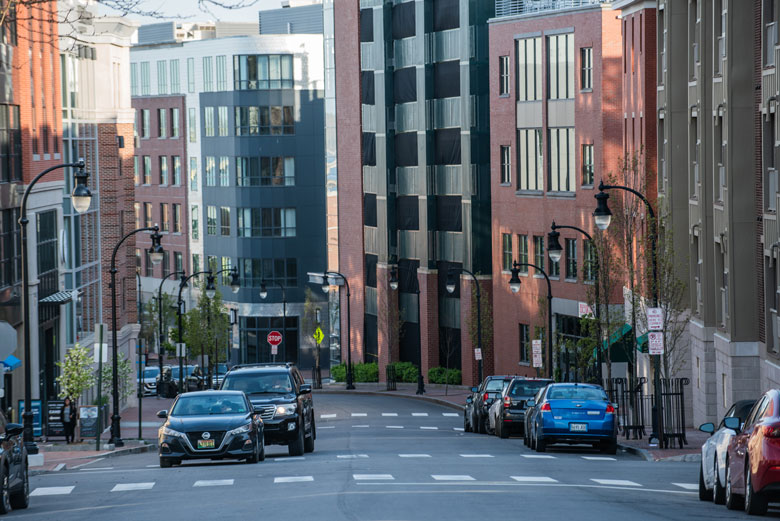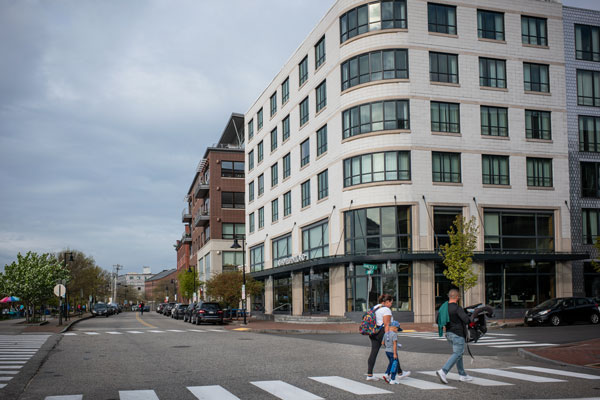
If you happen into the east end of the Portland waterfront for the first time in a long time, you might look around and ask yourself this: Where am I?
This area at the base of Munjoy Hill was historically industrial, known for railyards, heavy manufacturing, industrial warehouses, and a monstrous drydock called “The Hog” that was used to overhaul and modernize huge Navy destroyers.
But today, what’s known as the eastern waterfront has been transformed into an entirely new neighborhood with new streets, hotels and condos, parking garages, and steel-framed office buildings with dazzling amounts of glass.
The changes have come about incrementally over the past 15 years. Over time, the landscape has changed so much that you just might feel like you’re on a movie set.
Paul Stevens, a senior architect at SMRT, an architectural and engineering firm, lived near the eastern waterfront neighborhood for a number of years decades ago. His firm’s offices were in an aluminum-sided building (once used as railroad-era warehouse) in the waterfront zone for 26 years. The building is still standing, but today it’s surrounded by glistening office buildings that would have been unimaginable a generation ago.
When SMRT moved into the eastern waterfront building in the mid-1990s, it was essentially surrounded by dirt parking lots, Stevens said. On the nearby waterfront, BIW worked on ships and Cianbro Corp. constructed two massive oil rigs that towered 300-plus feet for shipping elsewhere.
The area is now barely recognizable compared to the old days, he said. When he drives down Hancock Street from partway up Munjoy Hill, he’s awestruck by the upscale condos, offices, and other development all the way down to the waterfront. When he reaches Thames Street, which runs parallel to the waterfront, he’s greeted by those large glistening office buildings.
“It’s very, very different. It’s amazing to me,” said Stevens. “When we moved our offices down there 30 years ago, there was literally nothing down there. It was just a huge dirt parking lot out in front of us.”
PLANNED DEVELOPMENT
Portland essentially has three waterfronts. The central waterfront with its 19th-century piers and wharves is the heart of Portland Harbor and supports commercial fishing, marine research, tourism, and nonmarine uses. The western waterfront, which has undergone its own transformation over the past decade, is dedicated to freight and industrial uses.
The eastern waterfront extends east from the Casco Bay Lines ferry pier, past Portland’s cruise ship terminal, and on to the former Portland Co. marine complex, which is now under development.
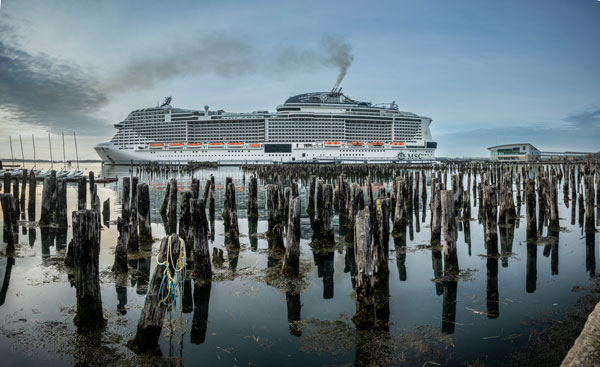
The area’s transformation was prompted by Bath Iron Works’ decision to end its repair yard operations in Portland. BIW leased the repair yard from 1982 to about 2001 from the city. The yard included two floating dry docks, one 844 feet long.
When BIW told the city in the late ‘90s that it was leaving, the city had to ask itself: What do we want to do with the city-owned property on that section of the waterfront?
The city council appointed a committee of more than 30 people with diverse interests who came up with a master plan for redevelopment of the eastern waterfront, looking at both city-owned land and adjacent privately owned property.
One part of the plan looked at marine infrastructure for international ferry vessels and cruise ships, and the other part was devoted to associated upland development, said Bill Needelman, Portland’s waterfront coordinator.
“This was all done on purpose,” he said while showing printouts of two aerial photos comparing the area in 2006, before the development, and 2021, when new streets and buildings had taken hold. “It was a plan.”
As a result, the Ocean Gateway marine terminal was built, opening in the spring of 2008. It’s used primarily by cruise ships and for a time served ferries that traveled between Portland and Nova Scotia.
To allow vehicles to get to the ferry, the city built Thames Street, an extension of Commercial Street from India Street to the east. And Hancock Street was built perpendicular to Thames Street to connect to Fore Street. Later, Thames Street was extended and another section of Hancock Street was built that runs from Fore Street to Middle Street, where it links to an older section of the original Hancock Street.
Along Thames Street, the first block east of India Street feels like an extension of Commercial Street, with a mix of smaller-scale condos, offices, some ground-floor retail stores, and the AC Hotel Portland, which opened in 2018.
But the next block is a head-turner, with its four-story, 100,000 square-foot, glass-sided building that opened in 2019 and serves as the headquarters for the payment-processing company WEX Inc.
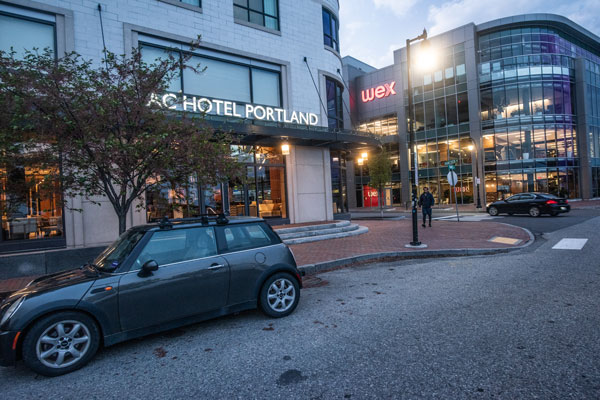
Beyond the WEX building stands another four-story glass-sided building that houses both WEX and the Roux Institute, a graduate school of Northeastern University. Last summer, Sun Life opened its own four-story building—this one with lots of glass and gray brick—in the neighborhood.
Those buildings use contemporary architectural styles, a stark contrast to the smaller red-brick buildings that dominate the central waterfront and the nearby Old Port.
The waterfront side of Thames Street includes the cruise ship terminal, a small harborside city park, the Maine Narrow Gauge Railroad, and the Eastern Promenade Trail pedestrian and bicycle corridor, which runs from Commercial Street to the city’s East End Beach.
THE HILL
With its contemporary architectural styles and upmarket development, the eastern waterfront stands out from the older clapboard-sided and multi-unit houses on the nearby streets of Munjoy Hill, parts of which retain a grittiness from bygone years even when being encroached upon by million-dollar condos.
Munjoy Hill, or simply “the Hill,” was once dominated by poor and lower middle-class Italian and Irish immigrants who lived in densely populated neighborhoods with single-family houses and triple-deckers. Many consider the neighborhood’s official boundary to begin at Washington Street, but others recognize anything east of Franklin Street to be part of the Hill.
The neighborhood today has become one of the most desirable—and expensive—areas to live in Portland, but at one time it was a place many avoided.
While having gorgeous views of Portland Harbor and the Casco Bay islands, the Hill in the ‘60s and ‘70s was dismissed as downright dodgy, a place to be avoided with its crime and alcohol and drug abuse. Munjoy Hill still retains a sense of neighborhood, but it’s also become gentrified over the past 25 years, with trendy restaurants, shops, and condos coming in, old corner neighborhood stores going out.
You know Munjoy Hill is a popular place when the local paper’s featured properties in its real estate section carries the headline “Condos under $1 million on Munjoy Hill.”
URBANIZATION OR SUBURBANIZATION?
While some may call the eastern waterfront a continuation of the urbanization of Portland’s waterfront area, others look at it as more of a suburbanization.
Barbara Vestal, who has lived on nearby Fore Street since 1978, thinks the area has the feel of a business park. Vestal is a retired lawyer who has been involved in planning matters for decades and served on the waterfront committee that developed the plan for the eastern waterfront more than 20 years ago.
The scale of the larger buildings, she said, seems overblown and is far different from what she envisioned while serving on the waterfront committee that developed the eastern waterfront master plan in the early 2000s. She was hoping for smaller buildings with individual owners, a variety of tenants and perhaps another cross street to break up the expanse of land.
Instead of a lively urban neighborhood, she says the eastern waterfront has a generic suburban feel that could be anywhere—suburban Boston, Pittsburgh, or Kansas City. Or Westbrook, she adds for good measure.
“I think to people who have been in Portland for a long time it’s not really recognizable as Portland,” she said. “When you’re in the middle of the new development, some buildings seem to me they belong in a suburban office park. There’s nothing that really says this has been influenced by Portland.”
Change, of course, is inevitable, and Portland has experienced many changes through the decades that transformed neighborhoods. Interstate 295 opened in the ‘60s, breaking up neighborhoods and providing easy highway access to the city.
Franklin Street was transformed into the four-lane Franklin Arterial throughway from I-295 to downtown and the waterfront in the ‘60s as part of an urban renewal project that razed dozens of homes and decimated neighborhoods.
A plan to redesign the road has been in the works for years, with the aim of transforming it back into a lively residential neighborhood with multi-use plazas instead of just a wide urban access road that gets cars into and out of the city. That plan, dubbed “Reclaiming Franklin Street,” is now moving forward; the city plans to work with a consultant to update its master plan beginning this summer and assess federal funding opportunities for a final design and construction in the fall of 2025. A construction timeline is still up in the air.
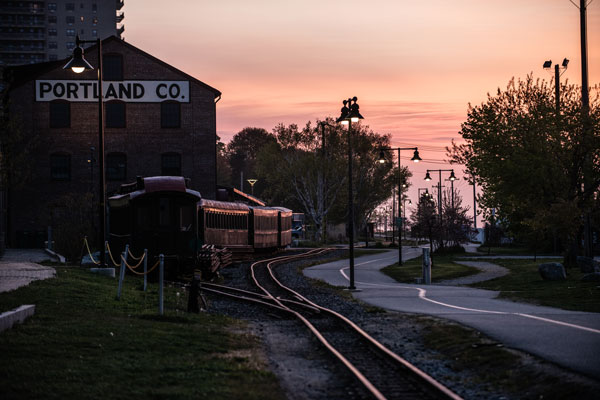
The waterfront, too, has gone through many changes. Trains still rumbled down Commercial Street and the Grand Trunk railyard in the eastern waterfront was busy with activity when Stevens moved back to his native Portland in 1966 to join the family architectural firm (founded by his great-grandfather, renowned architect John Calvin Stevens). The trains stopped running those routes in the early 1980s.
Along the eastern waterfront, even more changes will come. A development company plans to build hundreds of housing units, retail space, a luxury hotel and a huge parking garage on land that formerly housed the historic Portland Co. at the end of Thames Street. The complex has been dubbed Portland Foreside and basically transforms what was once a huge factory complex that manufactured steam locomotives and ship propulsion systems from the mid-1800s until 1982.
Developers have already built a modern 150-slip marina at the site and opened an upscale restaurant named Twelve, so named because the building it’s in was named “Building 12” when it was part of the manufacturing complex at the Portland Co. in days of yore. The Sun Life building is also part of the development.
On the water, the city is planning to build a 152-foot public dock for this boating season where transient recreational and island boaters can tie up for up to six hours while they’re in Portland. The city also plans to build a new public waterfront park where a parking lot is now located near India Street.
It remains to be seen what the impacts of the eastern waterfront will be on the city once it’s fully developed. Vestal says while the eastern waterfront has transformed the land, it hasn’t necessarily been transformational for the city.
“It’s kind of its own little world down there,” she said. “It’s not a place I tend to go. It’s not a destination.”
